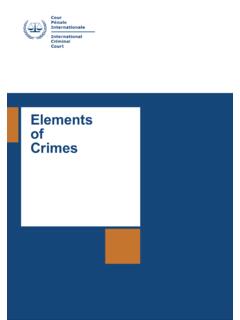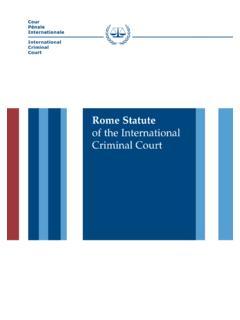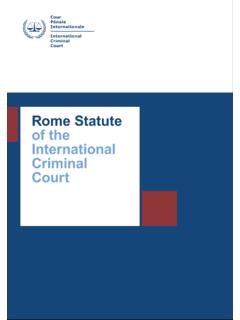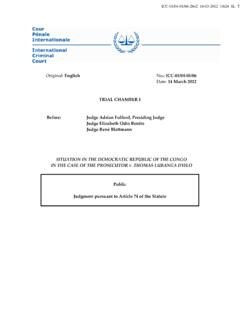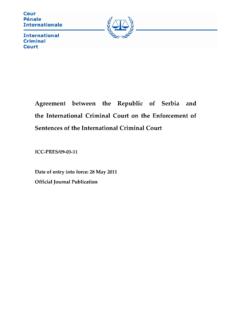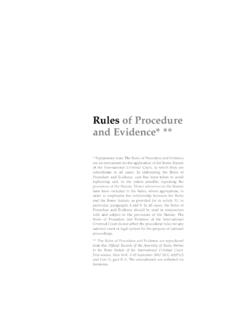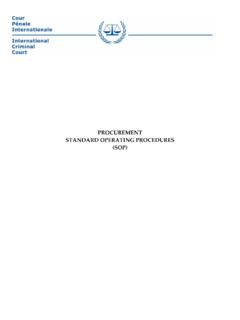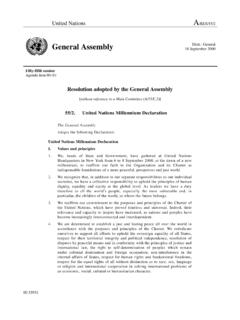Transcription of Understanding the International Criminal Court
1 Understanding the International Criminal CourtUnderstanding the International Criminal CourtUnderstanding the International Criminal CourtTable of ContentsI. The International Criminal Court at a glance 3II. Structure of the ICC 9 III. Crimes within the jurisdiction of the ICC 13IV. How does the ICC operate? 17 A. Referrals, analyses and investigations 17 B. Arrests 19 C. The rights of suspects 23 D. Confirmation of charges before trial 25 E. The trial 27 F. Judgment and sentence 31 G. Appeals and revision 32V. Victims Participation 35VI. Witness Protection 39 VII. Further information about the ICC 43 Understanding the International Criminal Court1 (.)
2 The most serious crimes of concern to the International community as a whole must not go unpunished (..) Preamble to the rome statute of the International Criminal CourtOn 17 July 1998, 120 States adopted a statute in Rome - known as the rome statute of the International Criminal Court ( the rome statute ) - establishing the International Criminal Court . For the first time in the history of humankind, States decided to accept the jurisdiction of a permanent International Criminal Court for the prosecution of the perpetrators of the most serious crimes committed in their territories or by their nationals after the entry into force of the rome statute on 1 July International Criminal Court is not a substitute for national courts.
3 According to the rome statute , it is the duty of every State to exercise its Criminal jurisdiction over those responsible for International crimes. The International Criminal Court can only intervene where a State is unable or unwilling genuinely to carry out the investigation and prosecute the primary mission of the International Criminal Court is to help put an end to impunity for the perpetrators of the most serious crimes of concern to the International community as a whole, and thus to contribute to the prevention of such well-informed public can contribute to guaranteeing lasting respect for and the enforcement of International justice.
4 The purpose of this booklet is to promote a better Understanding of the International Criminal Court by providing answers to the most frequently asked questions about the the International Criminal Court3I. The International Criminal Court at a glance 1. What is the International Criminal Court ?The International Criminal Court ( the ICC or the Court ) is a permanent International Court established to investigate, prosecute and try individuals accused of committing the most serious crimes of concern to the International community as a whole, namely the crime of genocide, crimes against humanity, war crimes and the crime of aggression.
5 2. Why was the ICC established? Some of the most heinous crimes were committed during the conflicts which marked the twentieth century. Unfortunately, many of these violations of International law have remained unpunished. The Nuremberg and Tokyo tribunals were established in the wake of the Second World War. In 1948, when the Convention on the Prevention and Punishment of the Crime of Genocide was adopted, the United Nations General Assembly recognised the need for a permanent International Court to deal with the kinds of atrocities which had just been idea of a system of International Criminal justice re-emerged after the end of the Cold War.
6 However, while negotiations on the ICC Statute were underway at the United Nations, the world was witnessing the commission of heinous crimes in the territory of the former Yugoslavia and in Rwanda. In response to these atrocities, the United Nations Security Council established an ad hoc tribunal for each of these events undoubtedly had a most significant impact on the decision to convene the conference which established the ICC in Rome in the summer of What is the rome statute ?On 17 July 1998, a conference of 160 States established the first treaty-based permanent International Criminal Court .
7 The treaty adopted during that conference is known as the rome statute of the International Criminal Court . Among other things, it sets out the crimes falling within the jurisdiction of the ICC, the rules of procedure and the mechanisms for States to cooperate with the ICC. The countries which have accepted these rules are known as States Parties and are represented in the Assembly of States Assembly of States Parties, which meets at least once a year, sets the general policies for the administration of the Court and reviews its activities. During those meetings, the States Parties review the activities of the working groups established by the States and any other issues relevant to the ICC, discuss new projects and adopt the ICC s annual budget.
8 4. How many countries have ratified the rome statute ?Over 120 countries are States Parties to the rome statute , representing all regions: Africa, the Asia-Pacific, Eastern Europe, Latin America and the Caribbean, as well as Western European and North Where is the seat of the Court ? The seat of the Court is in The Hague in the Netherlands. The rome statute provides that the Court may sit elsewhere whenever the judges consider it desirable. The Court has also set up offices in the areas where it is conducting How is the Court funded? The Court is funded by contributions from the States Parties and by voluntary contributions from governments, International organisations, individuals, corporations and other How does the ICC differ from other courts?
9 The ICC is a permanent autonomous Court , whereas the ad hoc tribunals for the former Yugoslavia and Rwanda, as well as other similar courts established within the framework of the United Nations to deal with specific situations only have a limited mandate and jurisdiction. The ICC, which tries individuals, is also different from the International Court of Justice, which is the principal judicial organ of the United Nations for the settlement of disputes between States. The ad hoc tribunal for the former Yugoslavia and the International Court of Justice also have their seats in The Hague. 8.
10 Is the ICC an office or agency of the United Nations?No. The ICC is an independent body whose mission is to try individuals for crimes within its jurisdiction without the need for a special mandate from the United Nations. On 4 October 2004, the ICC and the United Nations signed an agreement governing their institutional Is the ICC meant to replace national courts?No. The ICC does not replace national Criminal justice systems; rather, it complements them. It can investigate and, where warranted, prosecute and try individuals only if the State concerned does not, cannot or is unwilling genuinely to do so.
